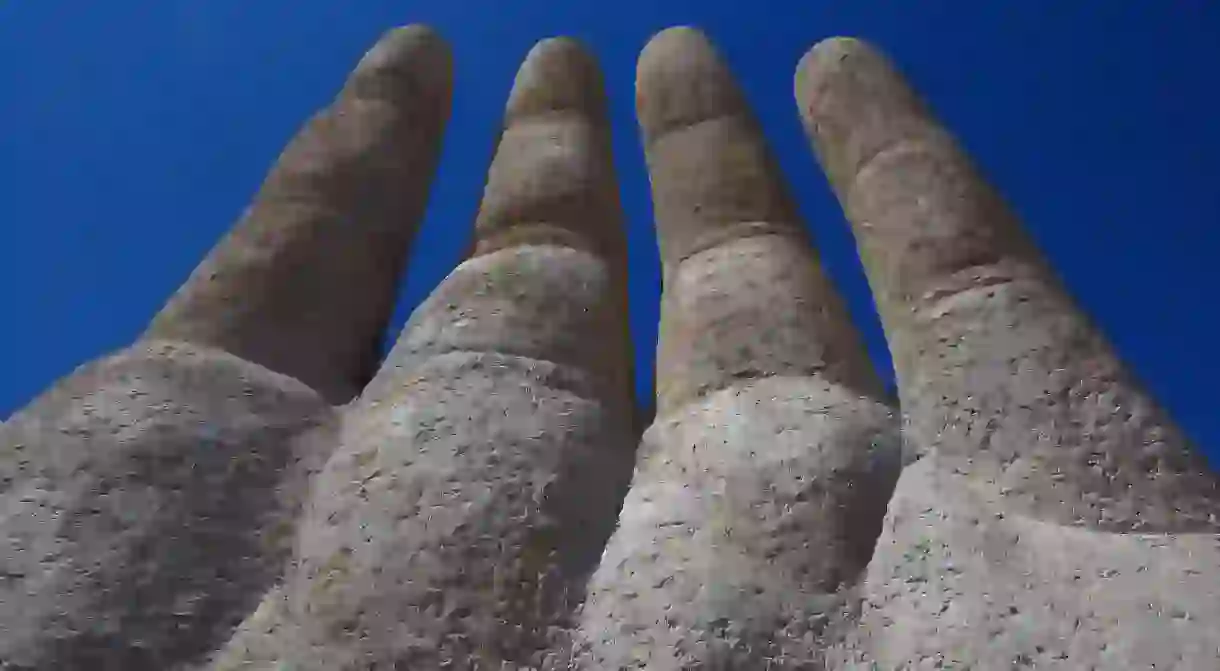Things to Know Before Visiting The Hand of the Desert, Chile

If you pass by this strange artistic expression in the middle of the Atacama Desert without any warning, you might think you have entered the movie Aladdin and some being is crawling out of the sand. Essentially, this is the effect that an expression of art such as this one is expected to have. But before you make your way into the Atacama Desert to see this marvelous sight, take the time to know a few things about what you’re going to see and where you are going.
It’s free
As art like this should be, the Mano del Desierto is completely free to approach and view, as there are no gates, fences or anything surrounding the sculpture, and it allows you to visit it at any time of the day. Do note that because of its remote location, it can be a victim of vandalization, and it is advisable to visit it during sunlight hours.

It’s far
Antofagasta claims possession of The Hand of the Desert because of its relatively close proximity. But only because it is the closest civilization to the monument does not mean it is a stroll from the city center, as the Hand is a hot 75 kilometers (46.6 miles) south, and a shade (no pun intended) inland from the coastal city of Antofagasta.
It’s huge!
The most captivating thing about the sculpture is its sheer size. It is a powerful figure and makes for a striking sight, especially in the massive expanse of nothingness, such as here in the middle of the Atacama Desert. Standing at over 11 meters, roughly 36 feet, this tall and thick structure stands more than double the height of a giraffe, or about the height of the average telephone pole.
Empty space
Its remote location is no accident as the artist behind its creation and construction, Mario Irarrázabal, was instructed by the city of Antofagasta to construct something notable to fill the empty space of the Atacama Desert. The enormous hand is located at an intersection where a few roads through the empty dry wasteland meet and head north towards Antofagasta.
Who is Mario Irarrázabal?
The mastermind behind the Mano del Desierto is the Chilean artist Mario Irarrázabal, who has won numerous awards over the years for his unique expressions, this one being arguably his most notable. The Santiago born artist attended university in the United States and also studied in Germany for years before returning in 1969 as a dedicated sculptor.
How to get there?
Being out of the way and in the direction of essentially nothing, getting there requires careful planning as it is next to impossible to arrive by public transportation. You can drive easily if you have a vehicle, or you can hire a taxi which will take you out there and wait to bring you back for a variety of prices. The prices will depend on your bartering skills but don’t expect anything lower than around $50 USD.

Don’t miss it!
Latin America is notorious for poor, or non-existent, signage, and people giving incorrect or vague directions when trying to assist, so keep this in mind. Many people will say that the sculpture is along Highway 5, when you will really need to make a turn off of it or you could pass it. When the main highway has a fork to go left to the B-55, you want to continue on the No 5, and be aware for the upcoming sign saying “Escultura” and the following path off to the right. This is your road to the Mano del Desierto.
Don’t climb it!
When looking up at the Hand of the Desert, your inner kid may come out and want to climb it, and even though it is not made of sand as it would appear, you are not allowed, nor would it be easy, to climb the giant appendage. You can go close, touch it, lean on it, but do not attempt to clamber up it, as tempting as it may be.
What does it represent?
Art is meant to spark the imagination and a piece of art will be viewed in a different way by each person, and that is one of the beautiful things about artistic expressions and one as big as this. When asked about it, Mario Irarrázabal said that the hand, the size, and the location all represent human vulnerability and helplessness – and those who run out of petrol here understand that perfectly well.
Monumento Al Ahogado
The Mano del Desierto may be Mario Irarrázabal’s most famous sculpture but he has another very similar one on the other side of South America in Uruguay. Located in the beach town of Punta del Este, the Monumento Al Ahogado (otherwise known as the Hand of Punta del Este), is still in the process of poking its fingers through the sand, but is a distinguishably similar work of art to the hand in Chile.
Did you know – Culture Trip now does bookable, small-group trips? Pick from authentic, immersive Epic Trips, compact and action-packed Mini Trips and sparkling, expansive Sailing Trips.













